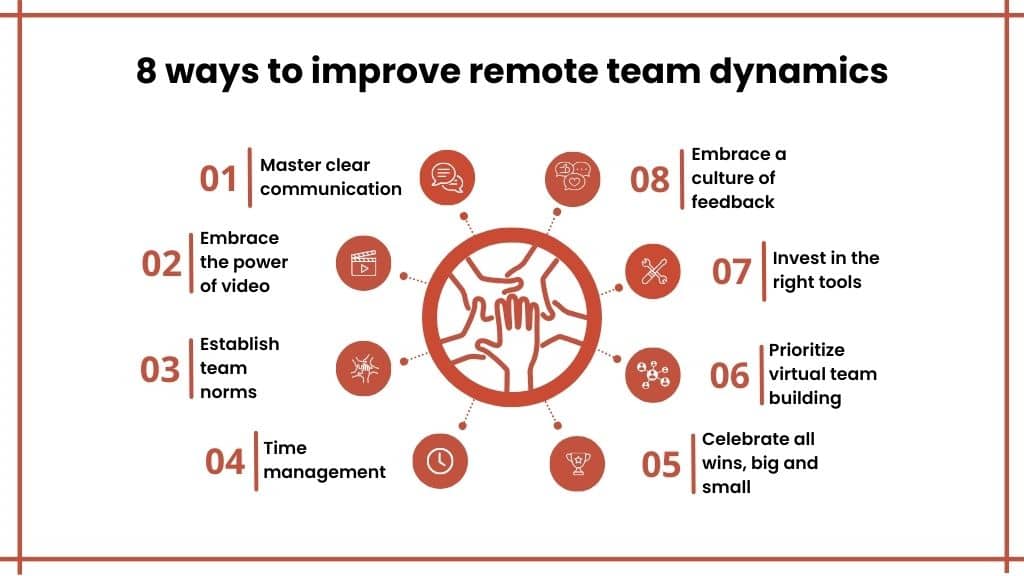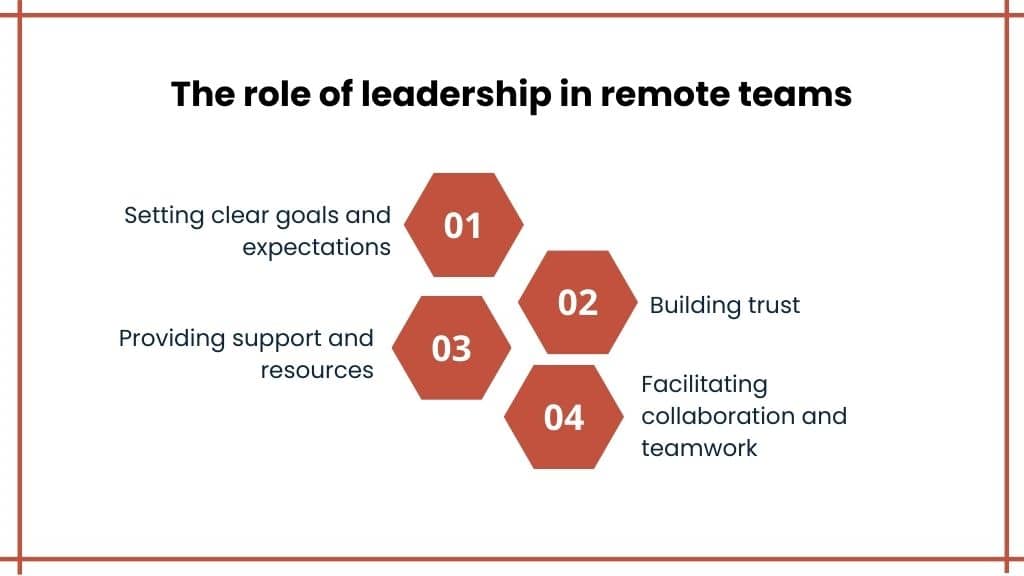Introduction
A study from Techopedia shows that 12% of full-time employees start working remotely in March 2024. Also, 40% of job seekers in the USA fully prefer remote work.
It states that remote work has a sustainable future.
Remote work offers advantages, but it also presents challenges for managers.
The biggest hurdle?
Maintaining visibility and fostering collaboration when your team is geographically dispersed. Building strong team dynamics in this environment requires extra effort, but the payoff is a high-performing remote team.
Don’t worry, Because this blog will help you in several ways. I am sharing with you eight effective ways to improve remote team dynamics. It will assist you in managing an entire remote team and provide creative ideas about team building.
Ready to turn your scattered team into a deadline-crushing machine? Let’s get started:
Why do team dynamics matter more than ever?
You need to understand that great teamwork is not a luxury but a necessity. Keeping this in mind, let’s know why team dynamics matters:
The importance of team dynamics
Team dynamics are similar to the engine of a car. Despite being hidden from the view, the engine plays a crucial role. It is important to keep the engine running for a smoother ride.
The same goes for the team. Strong team dynamics mean everyone works together at their best.
- Things get done faster: When people are coherent and can assist each other, the working process becomes smoother, and projects get done quickly.
- Better ideas are born: In organizations, there is also a need for independent professionals to express themselves; this way, the best solutions and ideas are born.
- Everyone feels happier: If everyone in the team is valued equally and their efforts are praised, it leads to better results and encourages the team to perform well.
The rise of remote work
Research by the World Economic Forum found that there will be a 25% hike in remote jobs by 2030.
Pre-pandemic trend: While working from home wasn’t exactly a thing of the past, the pandemic completely popularized it. Imagine fast internet, seamless video calls, and online tools to help you complete your work from anywhere. Companies that embrace remote work tend to gain a competitive edge early on.
Post-Pandemic Growth
- Increased job postings: Freelancing and other on-site companies like FlexJobs and Upwork started distributing remote jobs. Later on, there is a significant rise in remote jobs started taking place.
- Employee demand: Remote work provides a complete work-life balance. That’s why, companies allow their employees to work remotely so that they can acquire and retain talent within their organization.
- Shifting business landscape: Remote work has its benefits like high productivity, a broad talent pool, and better work-life balance. This results in hybrid work schedules or completely remote work as a long-term phenomenon.
Impact of strong team dynamics
Have you ever wondered why there is a significant difference between one team performing excellently and the other lagging on a project?
The answer is skill, tool, and communication. Adding these three factors improves remote team dynamics and productive outcomes.
In any industry or any department, strong team dynamics play a vital role. Here’s why:
- Get things done faster: Clear communication within your team leads to fewer mistakes and builds transparency, which helps you complete the project on time.
- Unleash your team’s creativity: Let your employees share their thoughts and ideas. This will help develop better solutions to problems and deliver quality work.
- Boost morale and happiness: Increase team morale and interest in the task by scheduling fun activities. It can be done once or twice a week.
- You will experience less stress: A systematic work plan helps you relax and focus on other tasks.
- Reach goals together: When everyone works together on the same task, then achieving goals becomes a team effort. It results in productive work.
Challenges of remote team dynamics
Managing an entire remote location team is quite challenging. Here is the list of common challenges:
- Communication breakdown: It can affect the team’s performance and raise conflicts. To overcome this, you need to conduct meetings, gather feedback, and communicate with the team consistently.
- Isolation and loneliness: Working from home can make team members feel isolated, lonely, and excluded from team activities. To keep their spirits high, schedule regular virtual check-ins and fun online activities.
- Building trust and cohesion: Trusting a team you don’t see daily takes effort. It also becomes a barrier to maintaining transparency. The only way to mitigate it is to Set clear expectations, provide regular feedback, and empower your team for a strong foundation.
- Collaboration & Coordination: Managing projects from different locations requires a solid plan. Your remote working team must be bound to a planned strategy. To bridge this gap, a project management tool, dedicated communication channels, and video calls can be helpful.
- Cultural mismatch: When your team is spread out in different countries or regions, it can be challenging to navigate various communication styles, work ethics, and even jokes or senses of humor that people relate to, such as sarcasm.
- Micro-management: You may be tempted to closely supervise everything because you are not physically present with them, but this will only discourage your employees. It takes extra work to build trust with your remote time.
Read this full guide: 9 Challenges of hybrid working and how you should tackle them
8 ways to improve remote team dynamics
Now, as you have considered all the challenges and importance of remote team dynamics. It’s time to know these eight ways to improve collaboration and strengthen your remote team:

1. Master clear communication
A study by Gartner states that 68% of employees cited communication failure as the cause of workplace problems.
Transparency between you and your team is the core of working in a remote, dynamic environment. That’s why you should define protocols for personal and work communication channels like email, chat, and video calls and their operational frequency.
This helps ensure that everyone has the required information and connection with their colleagues.
Also read: 8 Habits to keep your remote team engaged in 2024
2. Embrace the power of video
According to Forbes, 45% of the employees who work from home state that they feel more connected to their colleagues after video meetings.
Conducting videoconferencing helps the team collaborate with each other virtually, which enhances team engagement.
You should consider organizing a team meeting on a specific schedule, like after completing a task or weekly. Remember to tell all participants to turn their video on and make each one of them participate in the conversation.
3. Establish team norms
Get your ground rules sorted for your remote workers! This means settling on when one is supposed to be at work, how long each of them is expected to take to reply to a message, and any other aspects that may lead to misunderstanding.
The best way to realize it is through a discussion (possibly in a video call) that will help you find a compatible work schedule. This is actually a win-win option for you and your team.
Moreover, such expectations help develop goal-setting and ensure project discipline.
4. Time management
One of the major highlights in the case of remote teams is- when everyone is independently managing time as per the requirement, it is a boon. This means timely delivery of work, fewer setbacks during meetings, and people are present when there is a need for teamwork.
This is where the projects are kept on track without frustration. Time management also promotes better work-life balance.
Fixed working hours and response time ensure that nobody has to work overtime. Therefore, the management of time in remote teams improves. This results in an increase in the happiness level and success rate of the team.
5. Celebrate all wins, big and small
Research by Gallup found that employees who feel appreciated work 12% better.
This number does not stop here; it keeps on rising with every appreciation until your team gives you 100% satisfactory work.
You can directly post an announcement mentioning the name of the person’s department. Then, colleagues salute each other’s achievements on video calls or in your team chat.
6. Prioritize virtual team building
A study from Team Building Hub says that 55% of team leaders or managers found improvement in team culture after prioritizing team building.
The remote team doesn’t interact with each other physically, so they require ethical and team support to cheer up their work. To do that, you can arrange virtual games, online coffee meetings, and other activities apart from task discussions.
These activities are helpful in developing trust and making the collaboration more pleasant.
7. Invest in the right tools
The right choice of software for team collaboration helps ensure the team works smoothly.
Employing a project management tool for organizing projects, sharing files, team communication, and progress tracking is very helpful in improving remote team dynamics.
Read more: 11 Best business tools for entrepreneurs in 2024
8. Embrace a culture of feedback
Feedback is also essential because it keeps the work of the team productive and dynamic. However, in remote work scenarios, employees often ignore a rising issue. That’s why it is necessary to follow up with the team by planning a schedule.
It is recommended that you set up specific meetings to receive work-related feedback and queries.
Communicating issues with your team and embracing their ideas allows you to manage your remote team in the best possible way.
The role of leadership in remote teams
Leadership plays a crucial role in the success of the team. Let’s understand with some examples:

- Setting clear goals and expectations
It is necessary for managers who work with a remote team to provide goals for the particular team. It also reduces the chances of one or more people being out of sync.
Example: You can post an announcement that includes objectives, goals, results, expectations, availability, and deadlines to every team member. Thereafter, ask your team member to acknowledge or raise any query.
- Building trust
Different locations come with problems associated with the difficult flow of communication and contact. Teamwork in isolation means that the team can’t interact with fellow employees. Managers must spend time managing the trust between teams.
Example: Include team-building sessions, arranging casual get-to-know-each-other calls or chats, or creating a social calendar to provide ‘virtual water cooler’ breaks.
Continue reading: 9 Best practices for building trust in virtual teams
- Providing support and resources
It is essential to ensure your remote team has all the necessary equipment. This involves offering skills development, consultancy, and solving all the problems that a particular organization or its staff might encounter.
Example: To this end, the manager can facilitate proper skill development sessions or recommend additional online materials that help in improvement. The agenda is to keep the team up to date with current trends in the field.
- Facilitating collaboration and teamwork
It is often the case that members of the remotely located teams do not perform as well as cohesively. Especially when it comes to collaboration and teamwork since people can not meet each other face-to-face. It is the management’s responsibility to enhance cohesiveness in information sharing and generally create oneness within that team.
Example: You can set up cross-functional tasks and call for online meetings, where representatives from different areas are allowed to share their ideas.
The future of remote team dynamics
The rise of remote work flexibility is leading to new trends. Here are some trends that are taking place:
AI on Your Side
The rise of AI is bringing new changes in remote team dynamics. This will help organize your time schedules, translate language during phone conversations, provide audio subtitles in your preferred language during a video call, and many more.
VR meetings
Say goodbye to video call silence! With VR meeting rooms. VR meetings allow your team to have the feeling that they are meeting each other physically. It will not only improve team collaboration but also help you to tackle most of the remote workspace problems.
Data-driven team building
This will allow you to think about applying data to engage the teams. You can also arrange appealing, practical activities for remote employees. This could assist in the mapping of two or more people who have similar interests. It will help in deciding fun activities for team members, which will result in an improvement in remote team dynamics.
Location independence
Technology enhancement will allow people to work from anywhere. It also stands as a benefit for you as you can hire skilled staff from anywhere. It will allow you to have different team members with unique ideas.
Wrapping up
By implementing these eight tips, you can establish communication, boost collaboration, and unlock your team’s potential.
At first, you might feel it’s challenging, but with patience, you will realize that these tips are practical. To ensure long-term success, you must use the right team collaboration tools, up-to-date resources, and daily communication with your team to reach your success desires.
FAQs
How can you improve remote collaboration?
To improve collaboration, you have to maintain transparency, use collaboration tools, clear communication, and create an effective schedule.
What is the biggest challenge of remote working?
While managing a remote team, you might face these challenges: communication, trust building, task management, time gaps, distractions, and so forth.
How do you engage a team remotely?
You can follow these tips to engage a remote team:
- Regular communication
- Set clear goals
- Foster collaboration
- Encourage social interaction
- Recognition
- Flexible work environment
- Engage in fun activities
How do you motivate a team working remotely?
Motivating a remote team will require you to put extra effort into the team. You can simply conduct virtual meetings, gather feedback, and discuss strategies, and create solutions. You can also encourage innovation and creativity to motivate your team.

















No Comments